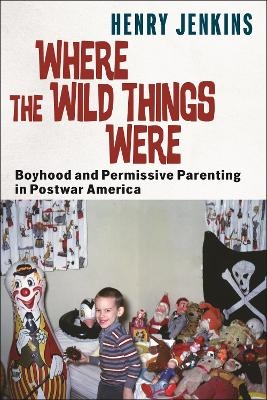
Where the Wild Things Were
Boyhood and Permissive Parenting in Postwar America
Seiten
2025
New York University Press (Verlag)
978-1-4798-3186-9 (ISBN)
New York University Press (Verlag)
978-1-4798-3186-9 (ISBN)
- Noch nicht erschienen (ca. Februar 2025)
- Versandkostenfrei
- Auch auf Rechnung
- Artikel merken
Explores iconic works from The Cat in the Hat to The Twilight Zone to explain cultural trends in parenting and how we conceptualize childhood
The 60s produced a Baby Boom generation that catalyzed the dawn of a new era—the space age, the age of television, the global age, and the beginnings of civil rights. At the same time, a new paradigm for parenting was unfolding that put emphasis on permissiveness, defined by what it permitted – the free and unfettered impulses of children. Others worried that the wildness of children, personified by the characters in Maurice Sendak’s 1963 classic children’s book, Where the Wild Things Are, was destructive, disruptive and disrespectful.
Where the Wild Things Were centers on the exploding, contentious national conversation about the nature of childhood and parenting in the postwar US emblematized by Dr. Spock’s Baby and Child Care. Renowned scholar Henry Jenkins demonstrates that the language that shaped a growing field of advice literature for parents also informed the period’s fictions—in film, television, comics, children’s books, and elsewhere—produced for and consumed by children. In particular, Jenkins demonstrates, the era’s emblematic child was the boy in the striped shirt: white, male, suburban, middle class, Christian, and above all, American.
Weaving together intellectual histories and popular texts, Jenkins shows how boy protagonists became embodiments of permissive child rearing, as well as the social ideals and contradictions that permissiveness entailed. From Peanuts comic strips and TV specials to The Cat in the Hat, Dennis the Menace, and Jonny Quest, the book reveals how childhood and the stories about it became central to Cold War concerns with democracy, citizenship, globalization, the space race, science, race relations, gender, and sexuality. Written by a former boy in a striped shirt, Where the Wild Things Were explores iconic works, from Mary Poppins to Lost in Space, contextualizing them through a critical but respectful engagement with the core animating ideas of the permissive imagination.
The 60s produced a Baby Boom generation that catalyzed the dawn of a new era—the space age, the age of television, the global age, and the beginnings of civil rights. At the same time, a new paradigm for parenting was unfolding that put emphasis on permissiveness, defined by what it permitted – the free and unfettered impulses of children. Others worried that the wildness of children, personified by the characters in Maurice Sendak’s 1963 classic children’s book, Where the Wild Things Are, was destructive, disruptive and disrespectful.
Where the Wild Things Were centers on the exploding, contentious national conversation about the nature of childhood and parenting in the postwar US emblematized by Dr. Spock’s Baby and Child Care. Renowned scholar Henry Jenkins demonstrates that the language that shaped a growing field of advice literature for parents also informed the period’s fictions—in film, television, comics, children’s books, and elsewhere—produced for and consumed by children. In particular, Jenkins demonstrates, the era’s emblematic child was the boy in the striped shirt: white, male, suburban, middle class, Christian, and above all, American.
Weaving together intellectual histories and popular texts, Jenkins shows how boy protagonists became embodiments of permissive child rearing, as well as the social ideals and contradictions that permissiveness entailed. From Peanuts comic strips and TV specials to The Cat in the Hat, Dennis the Menace, and Jonny Quest, the book reveals how childhood and the stories about it became central to Cold War concerns with democracy, citizenship, globalization, the space race, science, race relations, gender, and sexuality. Written by a former boy in a striped shirt, Where the Wild Things Were explores iconic works, from Mary Poppins to Lost in Space, contextualizing them through a critical but respectful engagement with the core animating ideas of the permissive imagination.
Henry Jenkins is Provost’s Professor of Communication, Journalism, Cinematic Arts and Education at the University of Southern California. He is the author or coauthor of twenty books including Textual Poachers: Television Fans and Participatory Culture, Convergence Culture: Where Old and New Media Collide, Spreadable Media: Creating Value and Meaning in a Networked Culture, and By Any Media Necessary: The New Youth Activism.
| Erscheint lt. Verlag | 25.2.2025 |
|---|---|
| Reihe/Serie | Postmillennial Pop |
| Zusatzinfo | 32 b/w and 9 color images |
| Verlagsort | New York |
| Sprache | englisch |
| Maße | 152 x 229 mm |
| Themenwelt | Sozialwissenschaften ► Kommunikation / Medien ► Medienwissenschaft |
| Sozialwissenschaften ► Soziologie ► Mikrosoziologie | |
| ISBN-10 | 1-4798-3186-7 / 1479831867 |
| ISBN-13 | 978-1-4798-3186-9 / 9781479831869 |
| Zustand | Neuware |
| Informationen gemäß Produktsicherheitsverordnung (GPSR) | |
| Haben Sie eine Frage zum Produkt? |
Mehr entdecken
aus dem Bereich
aus dem Bereich
wie KI und virtuelle Welten von uns Besitz ergreifen – und die …
Buch | Hardcover (2023)
Heyne (Verlag)
CHF 29,90
Buch | Softcover (2023)
Passagen (Verlag)
CHF 25,20


